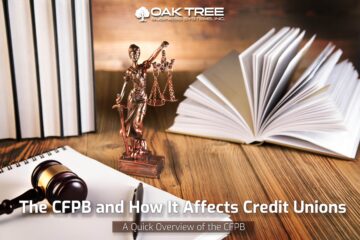
It may be difficult to keep up with the day-to-day operations of your credit union, let alone keep an eye out for regulatory updates and compliant standards which can cause some traffic buildup and closed roads to member services. We will look at a few credit union compliance signs you should remember.
Ideally, you would like to be consistently well-informed and up-to-date with all entities controlling regulatory restrictions within your credit union world. Unfortunately, it is so easy to be overwhelmed in operations and community involvement that you could miss something as simple as labeling a website image which causes compliance issues and potential lawsuits.
With Oak Tree, we watch the road for you so you can enjoy the views as your credit union travels compliantly into the future. Oak Tree legal and compliant teams keep your forms completely up-to-date so you can focus on your community.
Get a compliance review and chat with an agent today.
Does your credit union have all appropriate regulatory compliance signs in the branch?
- Patriot Act
- Home Mortgage Disclosure
- Funds Availability Policy
- Annual Disclosure Statement
- Community Reinvestment Act
- Combination Policy Signs
- Counter Policy Signs
- Digitally Printed Policy Signs
- Equal Employment Opportunity
- Equal Housing Lender – Credit Unions
- Equal Housing Opportunity
- SIPC Signs
- Thumbprint Signature
- Labor Law Signage
- Safety and Facility
- ADA Compliance Signage
Risk-Based Capital Rule
Five items were approved for risk-based capital rule by the NCUA a few years ago, those include:
- A proposed supplemental rule amends the agency’s prompt corrective action regulations to delay the effective date of the risk-based capital rule and raise the asset threshold defining a complex credit union.
- A $675,000 operating fund budget transfer to pay for cybersecurity improvements and employee relocation costs associated with the agency’s reorganization.
- Continuation of the current 18 percent annual interest rate limit for loans—with the exception of loans originated under the payday alternative loan program—through March 10, 2020.
- A final rule creating new suspension and debarment procedures to better protect the federal government’s interest in only doing business with presently responsible contractors.
- A proposed rule to add specificity and clarity to current regulations covering loans and lines of credit granted to members and to provide credit unions with regulatory relief.
As credit unions, it is your first priority to serve your members and help your community grow into financial stability and beyond. Both your institution and your members benefit from the efforts of fostering financial literacy in credit building with risk-based lending.
Members who are in the most need of a solid foundation provide the opportunity for substantial improvement. Along with financial advice and literacy advancement, your credit union can offer these members great rates in consumer lending. Without a proven history of solid credit, like other members, risk-based lending is named correctly.
Credit Union Youth: Teaching Financial Literacy
The youth represent the voice of a new generation and can give us a peak into what’s to come. Trends among young people help us understand what people like, and give us an understanding of what is important to them. When it comes to finances, developing a generation of financially literate people starts with early engagement. This means getting young people familiar with basic money management skills, and a general introduction to the world of finances. Most credit unions are already doing this with activities, events, and programs geared towards the youth that not only market their brand but provide a valuable service to the community as well. Your credit union may be one of the ones already doing this, but there are always other ways and ideas to improve your methods.
Flood Insurance
With summer ending, the US is approaching the uncertain harshness of the wetter, rainier seasons ahead. Last year we faced many natural disasters that caused flooding and property destruction for many of your members. Though flood insurance was in place, it is not solidly set for the future. Congress and higher legislation continue dishing out extensions without a more longtime/permanent solution to put the unknown flood-zone property owners at ease. For now, the pressure from both parties is in favor of extending flood insurance.


